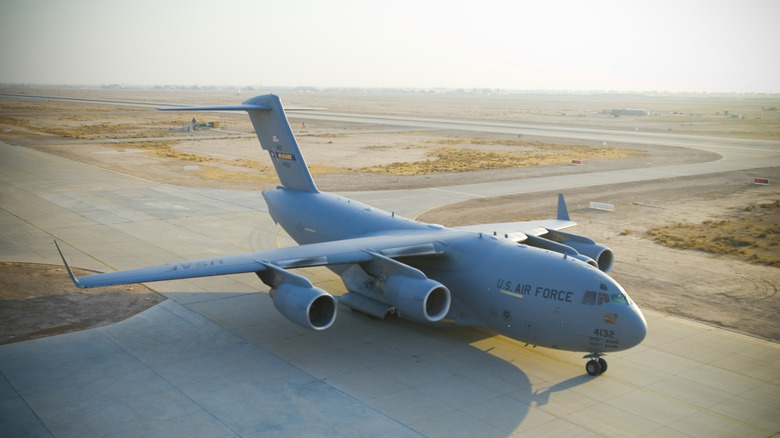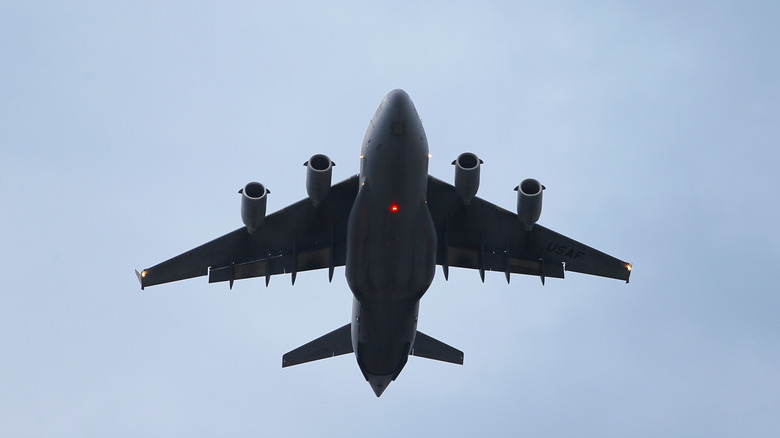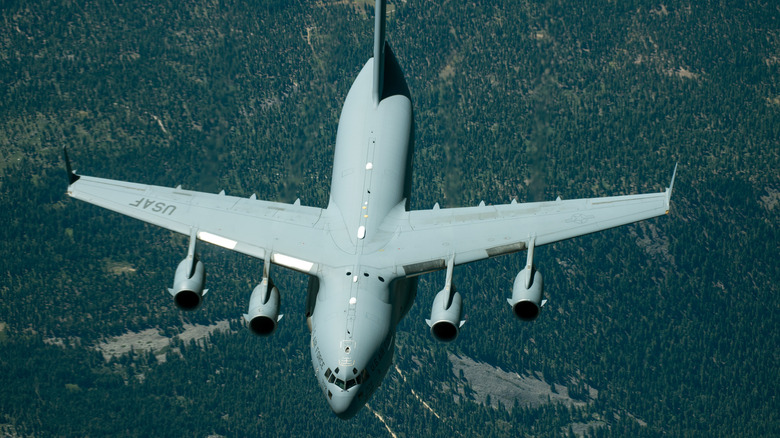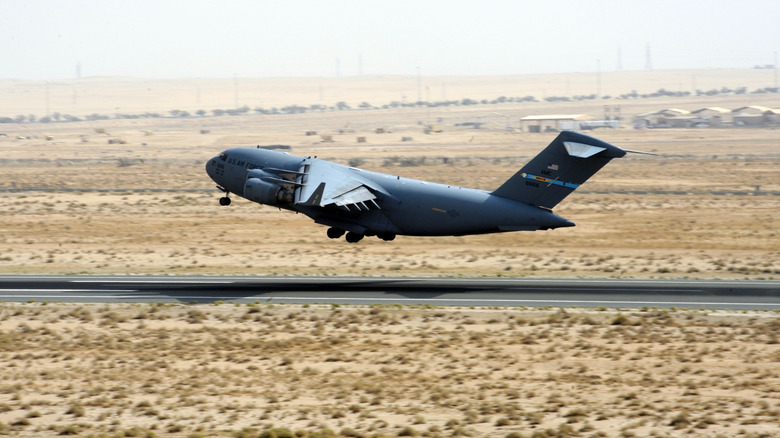Here's Why Boeing Discontinued The C-17 Globemaster III Military Cargo Aircraft
With its long history in the aviation industry, it's unsurprising Boeing has seen many changes to its fleets. As aviation technology improves, it's only natural that older units are replaced with more advanced, efficient models, especially when they are no longer as cost-effective to maintain or fit the existing mission requirements. Among the many notable Boeing aircraft cut from factory lines is the C-17 Globemaster III. Initially designed for the United States Air Force, Boeing said goodbye to the C-17 Globemaster III due to budget cuts and a lack of demand from the after successfully delivering for 20+ years.
Although the C-17 Globemaster III had its maiden flight in 1991, it took four more years until the first C-17 squadron became operationally ready. It's gotten a reputation as an incredibly versatile aircraft that has played a part in a wide range of transport missions for troops, cargo, and medical evacuation. This is possible, in part, due to its ability to work in short runaways and land in as little as 3,000 ft, while still being able to handle sizable payloads, which Boeing claims could go up to 110,000 lbs in sequential load drops. Powered by four F117-PW-100 turbofan engines designed by Pratt & Whitney, the C-17 Globemaster III doesn't just hold a max take off weight of over 290 tons, but it also boasts a whopping 40,440 lbs of thrust per engine.
Death by lack of demand: The end of the C-17 Globemaster III
Despite its maintainability, it wasn't enough for Boeing to continue the production of the C-17 Globemaster III. Similar to the reason the 747 was axed, Boeing announced its plans to stop manufacturing the C-17 because of the lack of demand in 2013. As of this writing, Boeing says 275 C-17s are still operational, and 80% are used by the U.S. Air Force.
During the 2024 World Defense Show, Boeing executive Torbjorn Sjogre said, "The C-17 is a product that does come up quite often. If we still had a lukewarm production line there are a number of customers who have expressed interest," according to FlightGlobal. Although, Sjogre shared that it would be expensive to restart production.
On the other hand, it seems its proposed successor had no problems taking off. In an interview with FlightGlobal, Boeing's VP for international business development, defense, space & security Vince Logsdon mentioned that he believes the Boeing P-8A Poseidon maritime surveillance aircraft could take the C-17's place. In February 2024, the U.S. Department of Defense awarded a $3.4 billion contract for a fleet of 17 P-8A aircrafts which are set to be delivered to Ottawa, Canada and Berlin, Germany.
Turbulent times for Boeing
Apart from supplying military cargo aircraft, Boeing is also known for its commercial airlines. In the past few years, Boeing has been at the center of some controversies, including the unfortunate incident when an emergency door came off mid-fight in one of its 737 Max planes earlier this year. In January 2024, passengers of an Alaska Airlines flight experienced a nightmare scenario, wherein the door came off its hinges and ended up in a residential area in Oregon.
Although there were no casualties in the Alaska Airlines flight incident, the same can't be said for previous incidents from Boeing planes in the last few years. In 2018, the ill-fated Lion Air crash in Indonesia led to the loss of 189 individuals, while an Ethiopian Airlines flight that crashed within the first six minutes of its flight took the lives of over 150 people a few months later. The non-prosecution agreement the company struck with the United States Department of Justice in the wake of those crashes was met with some controversy.
Why the C-17 might be resurrected again
As with all things that have proven to stand the test of time, fans of the C-17 Globemaster III may be validated by news of its possible revival. In June 2025, Boeing teased about talks of restarting the C-17's production during the Paris Air Show, citing the increasing demand in Europe. In a statement reported by Shephard Media, Boeing's VP and general manager of Boeing Global Services-Government shared that "It is a very extraordinary effort to do, but as reflective of the say the utility of the aircraft, that is something we are currently looking at with one particular country that has raised the possibility of doing so."
When it comes to reviving certain military aircraft lines, it's not unheard of for product lines to be restarted. After all, it has happened before in different ways, whether it's for fleet sustainment, foreign export, or modernization. In the past, there has also been a precedent of heavy airlifters being modernized for the needs of the United States Air Force, such as Lockheed Martin's C-5 Galaxy. Currently known as the largest aircraft in its inventory, the C-5M Super Galaxy received both an engine upgrade, as well as improved communication and safety systems. Only time will tell if the C-17 will go in this direction, but while the exact buyer (or the orders) for the revived C-17's has not been confirmed, we do know that the United States Air Force decided to take a different direction.
Next generation USAF aircrafts in the making
In September 2025, TWZ reported that instead of modernization, the United States Air Force has committed to make plans for an entirely new, next-generation aircraft. During the 2025 Air, Space, and Cyber Conference, Gen. John Lamontagne mentioned that the USAF is in the midst of developing the Next Generation Airlift (NGAL) platform. As of writing, no specific details have been released on the Air Force's latest requirements, except broad details about expected operational improvements, such as speed and flexibility. However, what we do know is that it's meant to surpass the performance of both discontinued heavy airlifters, the C-17 Globemaster III and the C-5M Galaxy.
Since the USAF has noted that it's set to begin in the mid-2040s, the ball is still in the air as far how this roll out will go. In the past, there have been notable instances of production plans dropping after initial testing, such as the Army's Future Attack Reconnaissance Aircraft (FARA) program's failed attempts at developing attack helicopters. Although, with recent appearances in the 2025 Paris Air Show, there's still a possibility that its efforts won't go to waste. Not to mention, there has also been no confirmed manufacturer yet for this new planned aircraft, whether it be Boeing, Lockheed Martin, or another manufacturer altogether. Knowing this, we'll all still have to wait more than a decade or so before we'll see it in the skies for ourselves.




